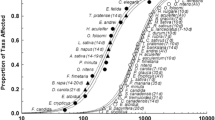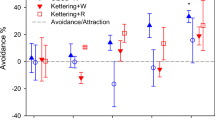Abstract
Purpose
Terrestrial ecotoxicology includes the investigation of the impact of chemicals on soils and soil-inhabiting organisms, whereby ecotoxicological effects are mainly assessed using single-species laboratory tests. As part of laboratory testing, reference substances, with known toxicity, are regularly used to confirm the sensitivity of the cultivated test organisms over time. Furthermore, reference substances are also applied in ring test evaluations for the validation of new test methods. The present work evaluates boric acid for its suitability as a potential reference substance for tests with higher plants and soil organisms (e.g., invertebrates and microbial communities).
Materials and methods
To enhance our existing knowledge, standardized acute and chronic laboratory tests with boric acid were performed and statistically evaluated using the following organism groups: microorganisms, higher plants, nematodes, enchytraeids, earthworms, collembolans, and beetles.
Results and discussion
The results demonstrated that boric acid was amenable for use in standardized laboratory tests using a wide range of microbes, plants, and soil invertebrates. Methodological problems were not identified. In addition, several organism groups demonstrated a hormetic response that must be taken into consideration when determining appropriate test concentration ranges for the use of boric acid as a reference substance. Finally, it was clear that the sensitivity of the different test species differed by about an order of magnitude (with the exclusion of microorganisms), which seems little when considering the wide taxonomic and physiological range of the organisms tested.
Conclusions
Based on the present results boric acid can be considered as a suitable reference substance in soil ecotoxicology. It is also recommended that the suitability (i.e., sensitivity, robustness, and practicability) be proven in international ring tests.
Similar content being viewed by others
References
Amorim MJB, Novais S, Römbke J, Soares AMVM (2008) Enchytraeus albidus (Enchytraeidae): a test organism in a standardised avoidance test? Effects of different chemical substances. Environ Int 34:363–371
Becker-van Slooten K, Campich S, Tarradellas J (2003) Research in Support of the Environment Canada Collembolan Toxicity Test Method with Folsomia candida for Assessment of Contaminated Soils. Report prepared for the Method Development and Applications Section, Environmental Technology Centre, Environment Canada, Ottawa, Ontario
Calabrese E, Baldwin L (2003) Hormesis: the dose–response revolution. Annu Rev Pharmacol Toxicol 43:175–197
Environment Canada (2005) Guidance Document on Statistical Methods for Environmental Toxicity Tests. EPS 1/RM/46. Environmental Protection Service, Environment Canada, Ottawa, Ontario
ESG International Inc, Aquaterra Environmental (2003) Assessment of the Biological Test Methods for Terrestrial Arthropods: Further Refinement of the Collembola Test Method Using Onychiurus folsomi. Report prepared for the Method Development and Applications Section, Environmental Technology Centre, Environment Canada, Ottawa, Ontario
Fent K (2003) Ökotoxikologie: Umweltchemie, Toxikologie, Ökologie 2nd revised and extended edition. Georg Thieme, Stuttgart
Goldberg S (1997) Reactions of boron with soils. Plant Soil 193:35–48
Gourmelon A, Ahtiainen J (2007) Developing test guidelines on invertebrate development and reproduction for the assessment of chemicals, including potential endocrine active substances—the OECD perspective. Ecotoxicology 16:161–167
Heimbach U, Dohmen P, Barrett KL, Brown K, Kennedy PJ, Kleiner R, Römbke J, Schmitzer S, Schmuck R, Ufer A, Wilhelmy H (2000) A method for testing effects of plant protection products on the carabid beetle Poecilus cupreus (Coleoptera, Carabidae) under laboratory and semi-field conditions. In: Candolfi MP, Blümel S, Forster R, Bakker FM, Grimm C, Hassan SA, Heimbach U, Mead-Briggs MA, Reber B, Schmuck R, Vogt H (eds) Guidelines to evaluate side-effects of plant protection products to non-target arthropods. IOBC/WPRS, OILB/SROP, pp 87–106
HERA (2005) Human and Environmental Risk Assessment on ingredients of Household Cleaning Products. Substance: Boric Acid (CAS No. 10043 35-3). 1st edition
Howe PD (1998) A review of boron effects in the environment. Biol Trace Elem Res 66:153–166, Humana Press Inc
Ingraldi S, Princz J, Scroggins R (2004) Comparison of E. andrei and E. fetida in their Response to Contaminated Soils. Unpublished technical report prepared for the Method Development and Applications Section, Environment Canada, Ottawa, Ontario
ISO 10390 (1994) Soil quality—determination of pH. International Organization for Standardization. Geneve, Switzerland
ISO 11269-2 (2004) Soil quality—determination of the effects of pollutants on soil flora—part 2: effects of chemicals on the emergence and growth of higher plants. International Organization for Standardization, Geneve
ISO 17512-2 (2007) Soil quality—avoidance test for testing the quality of soils and effects of chemicals—part 2: test with collembolans (Folsomia candida). International Organization for Standardization, Geneve, Draft
ISO 17512–1 (2008) Soil quality—avoidance test for testing the quality of soils and effects of chemicals on behaviour—part 1: test with earthworms (Eisenia fetida and Eisenia andrei). International Organization for Standardization, Geneve, Draft
ISO 10872 (2008) Water quality—determination of the toxic effect of sediment and soil samples on growth, fertility and reproduction of Caenorhabditis elegans (Nematoda). International Organization for Standardization, Geneve, Draft
Kalsch W, Junker T, Römbke J (2006) Modifications of a chronic plant test for the assessment of contaminated soils. Part II: testing of contaminated soils. J Soils Sediment 6:92–101
Kuperman RG, Checkai RT, Simini M, Phillips CT (2008) Baseline toxicity determination for the use of boric acid as reference toxicant in soil invertebrate toxicity testing with light-textured soils. Poster at the SETAC North America Conference, Tampa, USA. Edgewood Chemical Biological Center, Aberdeen Proving Ground, MD USA
Lautenschläger K-H, Schröter W, Teschner J (2002) Taschenbuch der Chemie. Wissenschaftlicher Verlag Harri Deutsch, Frankfurt am Main, 19th revised edition
OECD (2000) OECD Guideline for the Testing of Chemicals No. 216: Soil Microorganisms: Nitrogen Transformation Test. Organization for Economic Cooperation and Development, Paris, France
OECD (2004a) OECD Guidelines for the Testing of Chemicals No. 220: Enchytraeid Reproduction Test. Organization for Economic Cooperation and Development, Paris, France
OECD (2004b) OECD Guideline for the Testing of Chemicals No. 222: Earthworm Reproduction Test (Eisenia fetida/Eisenia andrei). Organization for Economic Cooperation and Development, Paris, France
OECD (2005) Guidance document on the validation and international acceptance of new or updated test methods for hazard assessment. OECD Environment, Health and Safety Publications, Series on Testing and Assessment No. 34. Organization for Economic Co-Operation and Development, Paris, France, p 96
OECD (2008) OECD Guideline for the Testing of Chemicals No. 226: Predatory mite (Hypoaspis (Geolaelaps) aculeifer) reproduction test in soil, Paris, France
OECD (2009) OECD Guideline for the Testing of Chemicals No. 232: Collembolan reproduction Test in soil, Paris, France
Park M, Li Q, Shcheynikov N, Zeng W, Muallem S (2004) NaBC1 is a ubiquitous electrogenic Na+-coupled borate transporter essential for cellular boron homeostasis and cell growth and proliferation. Mol Cell 16:331–341
Peylo A (2000) Bor im Holzschutz—Gibt es neue Erkenntnisse? Der praktische Schädlingsbekämpfer 52(4):28–31
Princz J (2004) Inter-laboratory Validation of Environment Canada's New Test Methods for Measuring Soil Toxicity Using Earthworms. Report prepared for the Biological Methods Division, Environment Canada, Ottawa, Ontario
Princz J (2006) Inter-laboratory Validation of Environment Canada's New Test Method for Measuring Soil Toxicity Using Plants. Report prepared for the Biological Methods Division, Environment Canada, Ottawa, Ontario
Römbke J, Ahtiainen J (2007) The search for the ‘ideal’ soil toxicity test reference substance. Integr Environ Assess Manag 3:464–466
Römbke J, Becker R, Moser H (2009) Ecotoxicological characterization of waste—results and experiences from an European ring test. Springer, New York, 308 p
Sakuma M (1998) PriProbit©: probit analysis of preference data. Appl Entomol Zool 33:339–347
Schafer AN, Snape I, Siciliano SD (2007) Soil biogeochemical toxicity end points for sub-antarctic islands contaminated with petroleum hydrocarbons. Environ Toxicol Chem 26:890–897
Stantec, Aquaterra Environmental (2004) Developmental Studies in Support of Environment Canada's Biological Test Methods for Measuring Soil Toxicity Using Earthworms. Report prepared for the Method Development and Applications Section, Environmental Technology Centre, Environment Canada, Ottawa, Ontario
Stephenson GL, Koper N, Atkinson GF, Solomon KR, Scroggins RP (2000) Use of nonlinear regression techniques for describing concentration–response relationships of plant species exposed to contaminated site soils. Environ Toxicol Chem 19:2968–2981
Streit B (1991) Lexikon Ökotoxikologie. VCH, Weinheim, 1st edition
ToxRatPro® Vers. 2.09 (2006): Toxicity Response Analysis and Testing. ToxRat® Solutions GmbH, D-52477 Alsdorf
Acknowledgments
We thank all colleagues at ECT GmbH who helped in one way or another with the practical work in the laboratory. In particular the input of Tiago Natal da Luz for his help with the collembolan avoidance test and the information provided by Sebastian Höss on the performance of the nematode test are acknowledged.
Author information
Authors and Affiliations
Corresponding author
Additional information
Responsible editor: Hailong Wang
Electronic supplementary material
Below is the link to the electronic supplementary material.
ESM 1
(DOC 301 kb)
Rights and permissions
About this article
Cite this article
Becker, L., Scheffczyk, A., Förster, B. et al. Effects of boric acid on various microbes, plants, and soil invertebrates. J Soils Sediments 11, 238–248 (2011). https://doi.org/10.1007/s11368-010-0282-7
Received:
Accepted:
Published:
Issue Date:
DOI: https://doi.org/10.1007/s11368-010-0282-7




